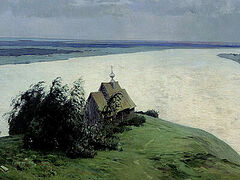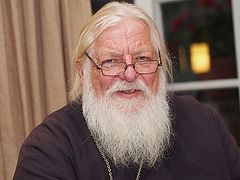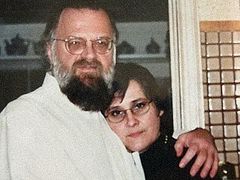The Church and our parents nurtured us in the Russian spirit
—I came to the U.S. at the age of six and grew up immersed in the local culture. But I never experienced any cultural conflicts. At that time, no one stopped us from living as Russian Americans: we organized a lot of events, concerts, balls, and there were Russian Scouts. We had a newspaper called Russian Life that only recently stopped being produced. The Church, our organizations and our parents all nurtured the Russian spirit in us. So I never felt as if my life was in conflict with surrounding society. I think I was quite successful in my youth, and I was proud to be able to immerse myself in the American culture while preserving the Russian culture and the Russian faith. When I first came to the Soviet Union as an interpreter in 1989, I was surprised to learn that there were few believers there. I thought that if you weren’t Orthodox, it was difficult to consider yourself Russian—so closely is our faith linked to our culture.
When I studied at the Russian school, we had our own little church and choir, and I even lead the choir for a while. We learned all the hymns and the liturgy by heart. We had lessons on the Law of God. The Orthodox faith is anything but simple, and you need to learn it. We had people telling us what’s where in the church, what this or that intonement means, or why it’s necessary to observe the feasts. Owing to this, we gained an understanding of Orthodoxy as a part of our culture from the ground up.
—Lydia Petrovna, how did you manage to forge your own path in America?
—My education was a bad fit for America. I graduated from the Teachers Institute in Latvia and taught in a Russian school. So, when we came here, I basically had no profession. But I consider myself lucky that, at that time, they began to offer Russian classes here; then, a new military school opened in Monterey, California. So, I worked there for five days and went home only on weekends to my family in San Francisco, which was located one hundred eighty kilometers away. I worked like that for several years. My mother-in-law took care of the children all that time.
This army school had an intensive language course, where the students had to learn the language in one year. They weren’t allowed to speak English with one another and they even wore headphones and listened to Russian speech at night.
Back then, the U.S. military who studied there had some crazy ideas about Russia and Russians. For example, they thought we didn’t use forks or knives, but ate with our hands and that bears roamed the streets of Russian towns. I have no idea where they got that! It’s probably because they were brought up that way, as we were enemies with them. It was so frustrating to me that they thought so badly of Russia. So, it was so important for me to show them true Russian culture. I wanted to show them a different kind of Russia. It worked, and I am really proud of it: my students enjoyed singing songs, we even had a choir and, in general, they learned to appreciate Russian culture. Thank God, they somehow believed me.
—Did any of your students, inspired by your example, later embrace Russian Orthodoxy?
—To my own shame, I haven’t really thought about it.
—Your life in America began in San Francisco, and the local Russian community is primarily associated with the name of the Holy Hierarch John of Shanghai and San Francisco. Did you know him?
Yury Andreyevich:
—Yes, of course. He arrived in San Francisco at a very crucial time. The local congregation was divided during the construction of our new cathedral church. People who raised money for its construction were accused of fraud. It was a high-profile case that made it even to the front pages of American newspapers. It practically split our diaspora in two. It got so bad that some people would even cross to the other side of the street anytime they saw us coming, because we stood firm for the builders of the cathedral and they were against them.
Our family took part in the construction of the Joy of All Who Sorrow Cathedral, where the relics of Vladyka John of Shanghai are kept
—The church stood half-way built for about four years while all that uproar and discord was going on. But when Vladyka John of Shanghai arrived, he restored peace and settled everything, and so its construction was completed. Our family took part in the construction of this cathedral named after the Joy of All Who Sorrow Icon of the Mother of God. The relics of Vladyka John rest there now.
—I’d probably be right if I said that the scouting organization you’ve been associated with for almost ninety years has been your all in all. Tell us about your work with the Russian Scouts in San Francisco.
Lydia Petrovna:
—We organized rallies and held summer camps. We also had Christmas and other celebrations. On Christmas, we used to perform different plays with Grandfather Frost and the Snow Maiden, and the children recited poetry. These were wonderful performances and we kept the Russian traditions alive. Besides, during the Christmas holiday, the Scouts went caroling to the homes of our elderly parishioners.
Yury Andreyevich:
—By the way, the tradition of Scouts singing carols has been preserved to this day. When our Scouts came to see my mother this Christmas, we recorded their singing for our video blog and it received thirty five thousand “likes” in response. People wrote, “How interesting that even in Russia no one does this anymore, but you preserved this tradition in America.”
We had about fifteen carolers and later had tea together. It was fun and very nice.
Lydia Petrovna:
—Yes, it was very nice, and I really liked that they didn’t forget me.
As for our work in San Francisco, at that time our Russian Center was the only one in the world. It was located in a large house purchased by people of the first wave of emigration back in the 1930s. It had a library, a Russian newspaper was printed there, and it also housed a large concert hall where we held our performances.
Scouting has greatly influenced the Russian diaspora, both culturally and morally
Yury Andreyevich:
—A lot of our emigrants were Scouts from their time back in Russia. The scouting movement originated in Germany, and it so happened that it was the Russians—in particular our famous Scoutmaster Boris Martino—who started it all anew after it was banned in the Soviet Union. Later these people moved to America and they brought these traditions to New York, Los Angeles, and San Francisco. Scouting helped the Russian diaspora very much, and particularly our family, both morally and culturally. For example, I reached the highest First Class rank and passed an examination in thirty-six Scouting subjects, including the Law of God. This allowed me to receive a new rank of a Scout of the Motherland. Each new rank was marked by a new background of the uniform patches—blue, red or green. But I received a white-blue-and-red background; I was the only Scout of the Motherland at the time.
But I never became a Scout leader, because we moved to Washington, D.C., where my mother started a new troop.
 Lydia Gerich in the Druzhina Putivl Scout troop camp in 2011
Lydia Gerich in the Druzhina Putivl Scout troop camp in 2011
—Lydia Petrovna, how did you found the “Druzhina Putivl” Scout Troop in Washington, which more than sixty years later has become one of the largest Russian Scout organizations in the United States?
—They had a Russian school here, so I came to the class and announced that we were organizing a scouting troop. The whole class signed up immediately and that’s how we began our work.
The children spoke English among themselves, and that surely upset their parents. So, the adults tried to get as many kids as possible to join the troop. In this way, our troop grew very quickly. We organized rallies and held camps. But most importantly, we helped these kids learn to speak Russian—it’s been a real problem here for some time. In the beginning, it was a challenge for us to set up our own camp, so we went to New York and visited the “Tsarskoe Selo” troop there. But then we were able to set up our own summer camp.
As time went on, our organization grew stronger; we can see the results today. The grandchildren of our first Scouts are now studying with us. We have always been attached to our Church and She has been very supportive of us.
 Scout jamboree. Pavlovsky Park. 1994. —In the early 1990s, I took part in the first Russian Scout Jamboree held in Russia’s Pavlovsk. It was outstanding! Can you imagine hundreds of children wearing the Scout uniforms, the same as ours? The Russian Scout leaders came up to us saying: “Thank you for bringing the scouting movement back to us.” It was so touching!
Scout jamboree. Pavlovsky Park. 1994. —In the early 1990s, I took part in the first Russian Scout Jamboree held in Russia’s Pavlovsk. It was outstanding! Can you imagine hundreds of children wearing the Scout uniforms, the same as ours? The Russian Scout leaders came up to us saying: “Thank you for bringing the scouting movement back to us.” It was so touching!
We also had a very interesting bonfire there. And everything was arranged exactly as we always had it here.
Yury Andreyevich:
—Our émigré community always had the celebration of the Remembrance of the Fallen Faithful. It is dedicated to the memory of Scouts who gave their lives for Russia. Not long ago, our troop sent us a list of leaders of the Organization of Russian Youth Scouts Abroad who died for Russia in exile, in prisons, and who perished in line of duty. It now has the names of about sixty leaders starting with Tsarevich Alexei, who was the first Russian scout. All in all, the number of scouts who gave their lives for their country runs into the hundreds and thousands.
—Not only did you found a scout troop in Washington DC, but you also participated in the construction of the Cathedral of St. John the Baptist. Practically the entire history of this parish, which founded by St. John of Shanghai in 1949, has passed before your eyes. What do you remember from this history?
Lydia Petrovna:
—When we moved to Washington, D.C., this church hadn’t been built yet. Services were held in a small room in one of the houses. Then Archimandrite Nicholas Pekatoros came and we began to raise funds for the construction of our own church. People made many sacrifices, especially by offering free labor—we didn’t hire workers, we did everything ourselves, and our family also did their part.
Yury Andreyevich:
—I joined in the final stages of the construction once I returned to Washington in 1979. It was already built, but it was so small! Then, a decision was made to expand it in height. The cathedral was built in the Moscow-Yaroslavl style of the seventeenth century.
At the time, we had only two people—a carpenter and priest—working on the construction. I was allowed to work as an apprentice carpenter, and so for two years we worked as a team. At the same time, services were held there every Sunday, and then, one fine day, when the work was finished, the congregation saw all of its beauty for the first time. The walls weren’t painted yet, and Archimandrite Cyprian (Pyzhov), who is called the iconographer of the Russian Diaspora, arrived from the Holy Trinity Monastery in Jordanville. He along with other monks worked in our cathedral for several years.
Mstislav Rostropovich [the famous composer] was in Washington at the time. He, along with Galina Vishnevskaya, donated several bells to our cathedral. They were made in Holland and were dedicated to Russian musicians whose names are engraved on them.
—How easy is it for you to keep your Orthodox faith in a foreign land these days? Does your faith help you?
Lydia Petrovna:
—Of course it helps! When we first came to America, we had to build our lives anew. And the Church gave us that critically important spiritual support. I think that without the Church, we simply wouldn’t have been able to go on.
Yury Andreyevich:
—I would go one step further and say that as we grow older, faith and the Orthodox Church penetrate even deeper into the human soul. It may be that when you are young, you don’t quite grasp this faith and all of its principles and ideals, but over the years, by contrast, everything just falls into place.
In terms of worship, the Church, has remained the same for hundreds of years. My great-great-grandfather, for example, prayed the same prayers that I am reading now. I once asked a monk if our faith had somehow changed over time. He replied, “No, we’ve kept everything the same way it’s been from the beginning.” Thanks be to God, at least something doesn’t change in our world! This is the rock on which we stand. And because of this, we can be Orthodox throughout our lives and feel very good about it. The Church is our constant source of inspiration, and the faith grows deeper and deeper. Now, at my age, I can’t even imagine what it’s like to live without it.
Our whole life has always been connected with the Church. It is the foundation of Russian culture in its entirety
My personal opinion is that Orthodoxy is the best faith in the world. When I was young, I studied Buddhism, Hinduism, learned a few things about Zoroastrianism, did some meditation, but, in the end, I returned to the Orthodox faith. Because it has everything the human soul ever needs.
Lydia Petrovna:
—Everything in our life has always been connected with the Church. This is where we spent all feasts and held meetings, where we brought our friends and acquaintances. This is the foundation of our Russian culture as a whole, so I can’t even imagine it without the Orthodox faith.




